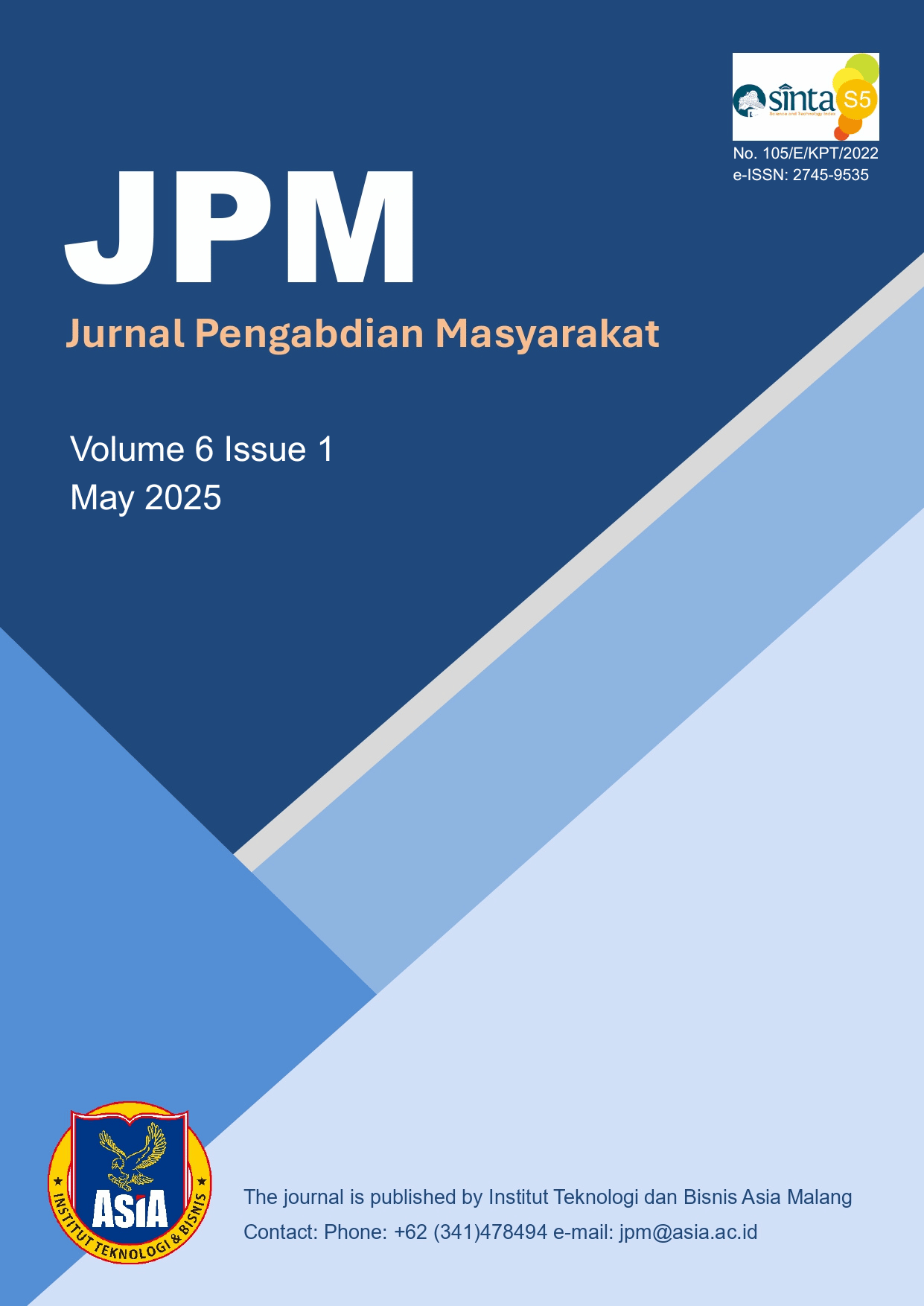Utilizing AI to Optimize Product Sales at UD Bima Baru
DOI:
https://doi.org/10.32815/jpm.v6i1.2454Keywords:
AI in Sales, Training Effectiveness, Optimizing, Skill Improvement, Innovation PromotionAbstract
Purpose: The study aims to evaluate the effectiveness of activities in reaching participants, achieving training goals, improving proficiency, and enhancing sales through AI technologies.
Method: This study teaches and evaluates the use of AI in sales optimization through lectures, demonstrations, tasks, and question-and-answer meetings. How well the activity worked is judged by how well the players met the goals and understood the material.
Practical Application: The participants from UD. Bima Baru showed high levels of enthusiasm and engagement during each session of the activity. This indicates the possibility for enhancing their skills, operational efficiency, and revenue, while also fostering collaboration and fostering creativity in the future.
Conclusion: Artificial intelligence (AI) has considerable potential to augment sales for MSMEs, like UD Bima Baru, through data-driven decision-making. Effective AI adoption requires practical experience, underscoring the significance of collaboration between academia and MSMEs in providing education, training, and mentorship. This collaboration fosters technological adoption and enhances local economic growth by generating practical, concrete ideas. Future training must include sequential courses for MSMEs to leverage AI.
References
Ahmad, I., Khan, I. A., Verma, A., & Sharma, S. (2023). Recent trends in sentiment analysis tools. 020054. https://doi.org/10.1063/5.0152220
Caldarini, G., Jaf, S., & McGarry, K. (2022). A Literature Survey of Recent Advances in Chatbots. Information, 13(1), 41. https://doi.org/10.3390/info13010041
Dhaliwal, N., Tomar, P. K., Joshi, A., Reddy, G. S., Hussein, A., & Alazzam, M. B. (2023). A detailed Analysis of Use of AI in Inventory Management for technically better management. 2023 3rd International Conference on Advance Computing and Innovative Technologies in Engineering (ICACITE), 197–201. https://doi.org/10.1109/ICACITE57410.2023.10183082
Gupta, C. P., & Ravi Kumar, V. V. (2024). Recommendation System: A transformative Artificial Intelligence Tool for E-commerce. 2024 7th International Conference on Informatics and Computational Sciences (ICICoS), 60–65. https://doi.org/10.1109/ICICoS62600.2024.10636825
Jansen, B. J., Jung, S., & Salminen, J. (2022). Measuring user interactions with websites: A comparison of two industry standard analytics approaches using data of 86 websites. PLOS ONE, 17(5), e0268212. https://doi.org/10.1371/journal.pone.0268212
Johari, N. M., Nohuddin, P. N. E., Baharin, A. H. A., Yakob, N. A., & Ebadi, M. J. (2022). Features requirement elicitation process for designing a chatbot application. IET Networks. https://doi.org/10.1049/ntw2.12071
Khneyzer, C., Boustany, Z., & Dagher, J. (2024). AI-Driven Chatbots in CRM: Economic and Managerial Implications across Industries. Administrative Sciences, 14(8), 182. https://doi.org/10.3390/admsci14080182
Klimova, I., Hordieieva, I., Sereda, N., Pashchenko, O., & Petecki, I. (2023). Strategic Marketing In A Dynamic Market Environment: Conhecimento & Diversidade, 15(40), 98–118. https://doi.org/10.18316/rcd.v15i40.11273
Misischia, C. V., Poecze, F., & Strauss, C. (2022). Chatbots in customer service: Their relevance and impact on service quality. Procedia Computer Science, 201, 421–428. https://doi.org/10.1016/j.procs.2022.03.055
Nguyen, T. T. H. (2023). Applications of Artificial Intelligence for Demand Forecasting. Operations and Supply Chain Management: An International Journal, 424–434. https://doi.org/10.31387/oscm0550401
Nze, S. U. (2024). AI-Powered Chatbots. Global Journal of Human Resource Management, 12(6), 34–45. https://doi.org/10.37745/gjhrm.2013/vol12n63445
Oluwaseun Badmus, Shahab Anas Rajput, John Babatope Arogundade, & Mosope Williams. (2024). AI-driven business analytics and decision making. World Journal of Advanced Research and Reviews, 24(1), 616–633. https://doi.org/10.30574/wjarr.2024.24.1.3093
Patnaik, R. (2024). Salesforce Einstein GPT: Pioneering Generative AI in CRM Technology. International Journal of Science and Research (IJSR), 13(6), 92–94. https://doi.org/10.21275/SR24523234811
Peesker, K. M., Kerr, P. D., Bolander, W., Ryals, L. J., Lister, J. A., & Dover, H. F. (2022). Hiring for sales success: The emerging importance of salesperson analytical skills. Journal of Business Research, 144, 17–30. https://doi.org/10.1016/j.jbusres.2022.01.070
Rjab, A. Ben, Mellouli, S., & Corbett, J. (2023). Barriers to artificial intelligence adoption in smart cities: A systematic literature review and research agenda. Government Information Quarterly, 40(3), 101814. https://doi.org/10.1016/j.giq.2023.101814
Taherdoost, H., & Madanchian, M. (2023). Artificial Intelligence and Sentiment Analysis: A Review in Competitive Research. Computers, 12(2), 37. https://doi.org/10.3390/computers12020037
Downloads
Published
How to Cite
Issue
Section
License
Copyright (c) 2025 Lilis Widayanti, Vivi Aida Fitria, Adriani Kala’lembang, Widya Adhariyanty Rahayu, Suastika Yulia Riska

This work is licensed under a Creative Commons Attribution 4.0 International License.





















